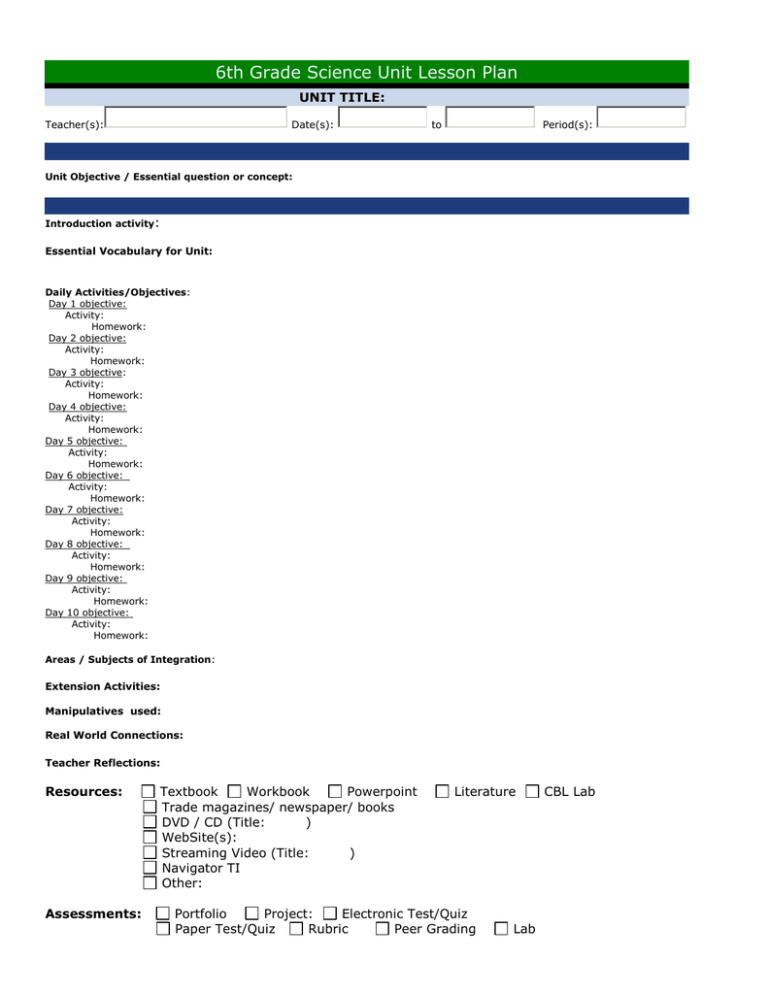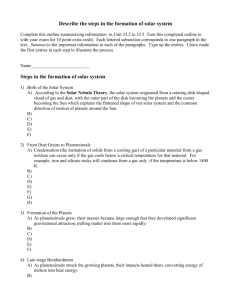Science Standards
advertisement

6th Grade Science Unit Lesson Plan UNIT TITLE: Teacher(s): Date(s): to Period(s): Unit Objective / Essential question or concept: Introduction activity: Essential Vocabulary for Unit: Daily Activities/Objectives: Day 1 objective: Activity: Homework: Day 2 objective: Activity: Homework: Day 3 objective: Activity: Homework: Day 4 objective: Activity: Homework: Day 5 objective: Activity: Homework: Day 6 objective: Activity: Homework: Day 7 objective: Activity: Homework: Day 8 objective: Activity: Homework: Day 9 objective: Activity: Homework: Day 10 objective: Activity: Homework: Areas / Subjects of Integration: Extension Activities: Manipulatives used: Real World Connections: Teacher Reflections: Resources: Assessments: Textbook Workbook Powerpoint Trade magazines/ newspaper/ books DVD / CD (Title: ) WebSite(s): Streaming Video (Title: ) Navigator TI Other: Literature Portfolio Project: Electronic Test/Quiz Paper Test/Quiz Rubric Peer Grading Lab CBL Lab Other: Alternative Assessments: 1) 2) 3) Instructional Strategies: Select One CRISS Strategies: Select One ELL Strategies: LA1. L.E.A. LA4. Picture dictionary LA7. Songs/poems LA10. Highlighters LA13. Comprehension LA16. High interest LA19. Balanced Literacy LA22. Semantic web LA25. Spell checker LA28. Oral language prep LA31. Song/music LA34. Adult tutor LA.37 Audio visuals LA40. Portfolios LA43. Oral test LA.46 Word bank Select One Select One Select One Select One LA2. Read Aloud LA5. Audio stories LA8. Games LA11. Themes LA14. Categories LA17. Spelling LA20 .Real life LA23. Write letters LA26. Drama LA29. Storytelling LA32. Silent time LA35. Relia LA38. Multi-sensory LA41. Grade modification LA44. Open book LA3. Picture file LA6. Flashcards LA9. Trade books LA12. Sight words LA15. Vocabulary/pictures LA18. Computers LA21. Oral skills LA24. Word identification LA27. Kinesthetic LA30. Cooperative learning LA33. Peer tutor LA36. Conputer instruction LA39. Bilingual dictionaries LA42. Teacher observation LA45. Test modification ESE Strategies: Preview content/concepts/vocabulary Repeat, review, summarize Preferential seating Reduced/shortened assignments Simplified instructions Graphic Organizers Extra time for completion Alternate quiz/test setting Use notes/study guides for tests Adjusted test format (ie..word bank, layout) Smaller manageable tests/quizzes for vocabulary assessment Copy of teacher notes Peer tutor/ teacher assistance Peer/teacher editing Frequent praise and recognition of success Use of calculator Use of highlighter Science Standards Big Idea 1:The Practice of Science SC.6.N.1.1 Define a problem from the sixth grade curriculum, use appropriate reference materials to support scientific understanding, plan and carry out scientific investigation of various types, such as systematic observations or experiments, identify variables, collect and organize data, interpret data in charts, tables, and graphics, analyze information, make predictions, and defend conclusions. SC.6.N.1.2 Explain why scientific investigations should be replicable. SC.6.N.1.3 Explain the difference between an experiment and other types of scientific investigation, and explain the relative benefits and limitations of each. SC.6.N.1.4 Discuss, compare, and negotiate methods used, results obtained, and explanations among groups of students conducting the same investigation SC.6.N.1.5 Recognize that science involves creativity, not just in designing experiments, but also in creating explanations that fit evidence. Big Idea 2: The Characteristics of Scientific Knowledge SC.6.N.2.1 Distinguish science from other activities involving thought. SC.6.N.2.2 Explain that scientific knowledge is durable because it is open to change as new evidence or interpretations are encountered. SC.6.N.2.3 Recognize that scientists who make contributions to scientific knowledge come from all kinds of backgrounds and possess varied talents, interests, and goals. Big Idea 3: The Role of Theories, Laws, Hypothesis, Models SC.6.N.3.1 Recognize and explain that a scientific theory is a well-supported and widely accepted explanation of nature and is not simply a claim posed by an individual. Thus, the use of the term theory in science is very different than how it is used in everyday life. SC.6.N.3.2 Recognize and explain that a scientific law is a description of a specific relationship under given conditions in the natural world. Thus, scientific laws are different from societal laws. SC.6.N.3.3 Give several examples of scientific laws. SC.6.N.3.4 Identify the role of models in the context of the sixth grade science benchmarks. Big Idea 5: Earth in Space and Time SC.8.E.5.1 Recognize that there are enormous distances between objects in space and apply our knowledge of light and space travel to understand this distance. SC.8.E.5.2 Recognize that the universe contains many billions of galaxies and that each galaxy contains many billions of stars. SC.8.E.5.3 Distinguish the hierarchical relationships between planets and other astronomical bodies relative to solar system, galaxy, and universe, including distance, size, and composition. SC.8.E.5.4 Explore the Law of Universal Gravitation by explaining the role that gravity plays in the formation of planets, stars, and solar systems and in determining their motions. SC.8.E.5.5 Describe and classify specific physical properties of stars: apparent magnitude (brightness), temperature (color), size, and luminosity (absolute brightness). SC.8.E.5.6 Create models of solar properties including: rotation, structure of the Sun, convection, sunspots, solar flares, and prominences. SC.8.E.5.7 Compare and contrast the properties of objects in the Solar System including the Sun, planets, and moons to those of Earth, such as gravitational force, distance from the Sun, speed, movement, temperature, and atmospheric conditions. SC.8.E.5.8 Compare various historical models of the Solar System, including geocentric and heliocentric. SC.8.E.5.9 Explain the impact of objects in space on each other including: 1. the Sun on the Earth including seasons and gravitational attraction 2. the Moon on the Earth, including phases, tides, and eclipses, and the relative position of each body. SC.8.E.5.10 Assess how technology is essential to science for such purposes as access to outer space and other remote locations, sample collection, measurement, data collection and storage, computation, and communication of information. SC.8.E.5.11 Identify and compare characteristics of the electromagnetic spectrum such as wavelength, frequency, use, and hazards and recognize its application to an understanding of planetary images and satellite photographs. SC.8.E.5.12 Summarize the effects of space exploration on the economy and culture of Florida. Big Idea 6: Earth Structures SC.6.E.6.1 Describe and give examples of ways in which Earth's surface is built up and torn down by physical and chemical weathering, erosion, and deposition. SC.6.E.6.2 Recognize that there are a variety of different landforms on Earth's surface such as coastlines, dunes, rivers, mountains, glaciers, deltas, and lakes and relate these landforms as they apply to Florida. SC.7.E.6.1 Describe the layers of the solid Earth, including the lithosphere, the hot convecting mantle, and the dense metallic liquid and solid cores. SC.7.E.6.2 Identify the patterns within the rock cycle and relate them to surface events (weathering and erosion) and sub-surface events (plate tectonics and mountain building). SC.7.E.6.3 Identify current methods for measuring the age of Earth and its parts, including the law of superposition and radioactive dating. SC.7.E.6.4 Explain and give examples of how physical evidence supports scientific theories that Earth has evolved over geologic time due to natural processes. SC.7.E.6.5 Explore the scientific theory of plate tectonics by describing how the movement of Earth's crustal plates causes both slow and rapid changes in Earth's surface, including volcanic eruptions, earthquakes, and mountain building. SC.7.E.6.6 Identify the impact that humans have had on Earth, such as deforestation, urbanization, desertification, erosion, air and water quality, changing the flow of water. SC.7.E.6.7 Recognize that heat flow and movement of material within Earth causes earthquakes and volcanic eruptions, and creates mountains and ocean basins. Big Idea 7: Earth Systems and Patterns SC.6.E.7.1 Differentiate among radiation, conduction, and convection, the three mechanisms by which heat is transferred through Earth's system. SC.6.E.7.2 Investigate and apply how the cycling of water between the atmosphere and hydrosphere has an effect on weather patterns and climate. SC.6.E.7.3 Describe how global patterns such as the jet stream and ocean currents influence local weather in measurable terms such as temperature, air pressure, wind direction and speed, and humidity and precipitation. SC.6.E.7.4 Differentiate and show interactions among the geosphere, hydrosphere, cryosphere, atmosphere, and biosphere. SC.6.E.7.5 Explain how energy provided by the sun influences global patterns of atmospheric movement and the temperature differences between air, water, and land. SC.6.E.7.6 Differentiate between weather and climate. SC.6.E.7.7 Investigate how natural disasters have affected human life in Florida. SC.6.E.7.8 Describe ways human beings protect themselves from hazardous weather and sun exposure. SC.6.E.7.9 Describe how the composition and structure of the atmosphere protects life and insulates the planet.






